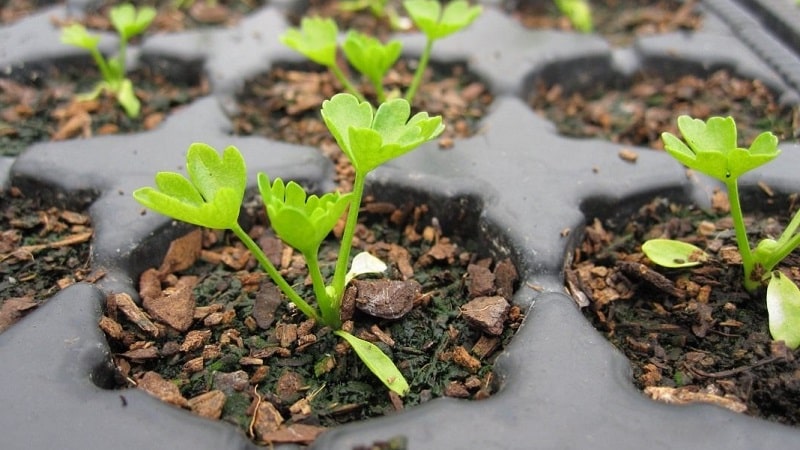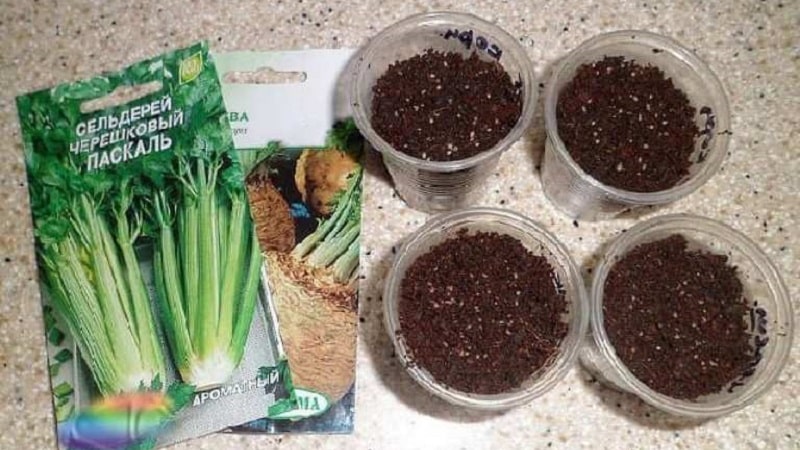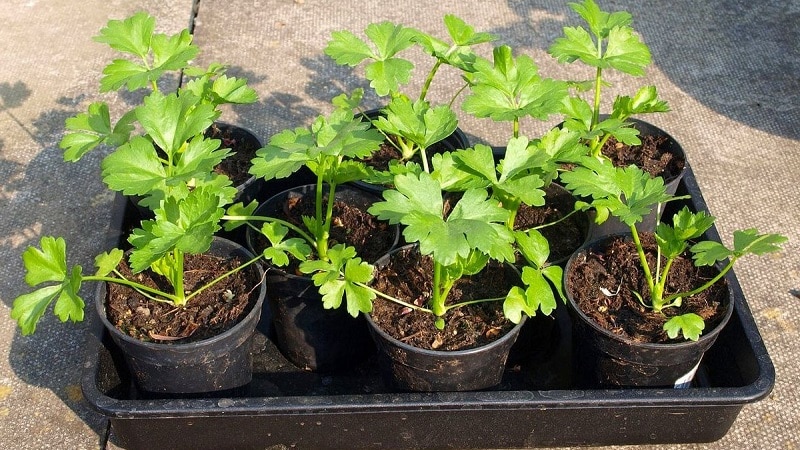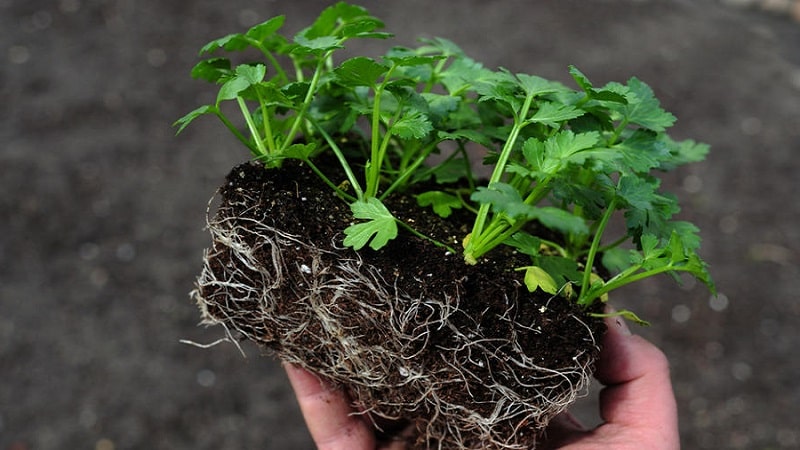Step-by-step instructions: how to grow celery from seeds at home for seedlings
The method of growing celery depends on the type of crop. Leaf and petiole varieties can be planted directly in heated soil, but root varieties require mandatory seed germination. However, given the long growing season of the crop, and for the leafy variety it takes about 50 days from germination to the appearance of foliage, the expected result can only be achieved by first growing the seedlings.
In this material we have collected information about the timing of sowing seeds, their pre-sowing preparation, features of care and transfer of seedlings to open ground.
Features of growing celery seedlings at home
Celery is one of the healthiest vegetables with a unique set of vitamins and minerals.
There are three types of culture: root, petiole and stem celery. Each of them is grown through seedlings. This rule is especially applicable to the root species due to the long growing season and low seed germination. When sowing directly into the ground, there is a risk of not getting a harvest in a short summer.

Crop ripening time from the moment of emergence:
- root - 140–190 days;
- petiole - 80–180 days depending on varietal characteristics;
- leafy - 50 days.
Adult plants can withstand frosts down to -5°C, but young seedlings die at this temperature.Therefore, for transferring seedlings to open ground, the timing is selected, focusing on the weather conditions of each individual area.
Important! For cultivation, it is better to choose early varieties and start sowing seedlings in February.
Landing dates
When to sow celery for seedlings? Sowing of seeds begins 60-80 days before transferring the seedlings to a permanent place. Optimal dates are chosen according to the lunar calendar.
Sowing dates for root celery in 2020:
- in January: 1, 5-9, 11, 27-29;
- in February: 10-15, 17-20, 24 and 25;
- in March: 3-6, 17, 18, 22, 27-30;
- in April: 5-7, 10-14, 18, 19, 23, 25-29;
- in May: 2-6, 15-17, 24-26, 30 and 31;
- in June: 1-4, 6-8, 12, 13, 22, 23, 26-30;
- in July: 1-5, 9, 10, 14, 15, 23-31;
- in August: 1, 2, 5-7, 10-16, 21-26, 28 and 29;
- in September: 3, 6-13, 18-25, 30-31;
- in October: 4-10, 13, 14, 17-23, 26, 27 and 31;
- in November: 1-6, 10-13, 16-19, 22-24, 27-30;
- in December: 2-4, 15-21, 25-31.
Sowing dates for petiole and leaf celery in 2020:
- in January: 1, 5-9, 11, 27-29;
- in February: 10-15, 17-20, 24 and 25;
- in March: 3-6, 17, 18, 22, 27-30;
- in April: 5-7, 10-14, 18, 19, 23, 25-29;
- in May: 2-6, 15-17, 24-26, 30 and 31;
- in June: 1-4, 6-8, 12, 13, 22, 23,26-30;
- in July: 1-5, 9, 10, 14, 15, 23-31;
- in August: 1, 2, 5-7, 10-16, 21-26, 28 and 29;
- in September: 3, 6-13, 18-25, 30-31;
- in October: 4-10, 13, 14, 17-23, 26, 27 and 31;
- in November: 1-6, 10-13, 16-19, 22-24, 27-30;
- in December: 2-4, 15-21, 25-31.

Moon phases affect plant growth: greens actively develop during the waxing moon, root crops during the waning moon.
Considering the diversity of climatic zones in our country, when it comes to sowing celery seedlings, it is better to focus on weather conditions in the regions.
Interesting on the topic:
Growing leaf celery in open ground
Root celery has a long ripening periodTherefore, seeds are sown 60–80 days before transplantation. In the north of the country, sowing begins at the end of January and ends in mid-February.
In the regions of the central zone, sowing is carried out throughout February. In the south, the optimal period for sowing is the second ten days of February - the first ten days of March.
Timing for sowing petiole celery:
- in the south - the last ten days of March - the first ten days of April;
- in the regions of the middle zone - all of March;
- in the north - sowing work is completed before March 10.
Sowing leaf celery for seedlings in the northern regions It is rational to produce in the second ten days of March. Residents of the middle zone do not need to fear frosts at the beginning of summer, so sowing seeds begins in early April.
How to grow celery seedlings from seeds at home
To obtain healthy and strong celery seedlings, it is important to follow the rules selection of seeds, their pre-sowing preparation, optimal watering and fertilizing.

Seed preparation
The final result depends on the quality of the seeds - plant health, root size, taste and aroma. To get the expected result, pay due attention to the choice of planting material:
- Buy fresh seeds that expire next year.
- Give preference to Dutch selection seeds with high yields.
- Choose large-fruited root celery seeds if you want to get a vegetable weighing up to 500 g.
- Take early ripening varieties, otherwise the root crops will not have time to ripen.
Before sowing, the seeds are stratified: Wrap in damp gauze and leave at room temperature for a week, then place in the refrigerator for 12-14 days. This creates natural conditions when seeds overwinter in the ground and sprout in spring.
Growing containers
For sowing seeds followed by picking Any plastic container, tetrapacks, pots or special cassettes for seedlings are suitable.
It is recommended to plant celery root seeds directly into individual glasses. with drainage holes at the bottom. This is explained by the fact that seedlings do not tolerate picking well, and it is advisable not to disturb the root system again. There is a risk of damaging the main root, and as a result, not a large root crop will grow, but a sponge of many roots.
Soil preparation
Soil for celery seedlings prepared from garden soil, river sand, peat, sawdust, crushed eggshells. The components are mixed in equal proportions and disinfected in the oven or spilled with a strong infusion of potassium permanganate. For every 10 kg of substrate take 20 g of urea and 200 g of wood ash.

Landing
Before sowing, the soil is moistened abundantly with clean water at room temperature. and embed the grains to a depth of 5 mm. It is important to keep the soil moist, so watering is done as the top layer dries out. After 14 days, preventive spraying is carried out with Trichodermin (10 mg per 1 m²).
Seedling care
Until the sprouts appear, the boxes are kept under film cover. in a dark room at a temperature of +20...+22°C, then transferred to a lighted place.
After the first leaves appear, the temperature is reduced to +12...+16°C, and after 10 days it is increased to +20...+25°C.Strong seedlings of leaf and petiole celery with 3-5 leaves are picked and transplanted into separate containers, choosing the strongest specimens and shortening the central root. This promotes the growth of green mass due to the supply of nutrients to the ground part.
For transplantation, use separate cups with a diameter of at least 6 cm, in the bottom of which holes are made to drain excess water. The container is filled with the same substrate as when planting, a depression of 2-2.5 cm is made, and watered with a syringe. Carefully dig up the seedlings with a teaspoon and place them in the hole. Sprinkle soil on top, leaving the cotyledon leaves on the surface. Then the plants are watered with clean, settled water and fed with “Gumi” (6 drops per 1 liter).
After picking, the seedlings are left in a dark place for 2–3 daysto reduce stress, then exposed to sunlight. If necessary, the sprouts are illuminated with a phytolamp. The norm of daylight hours for celery is 12-14 hours. The optimal air temperature is +18…+22°С.
Reference. Water the seedlings carefully, through a sieve, 1-2 times a week, adding Fitosporin-M. The soil is loosened with a peg, trying not to touch the roots.
Scheme for feeding seedlings:
- 14 days after sowing, add chicken manure (1 tsp per 3 liters of water);
- subsequent feedings are carried out every 10 days - “Nitrophoska” and chicken manure in turn (1 tsp per 3 liters of water).
3 weeks before planting in the ground, seedlings are taken out into the open air. in partial shade for hardening.

Transplantation into open ground and further care
When to plant mature seedlings? Seedlings are transplanted into open ground in the third decade of May. In this case, it is desirable that the sprouts reach a height of 20-25 cm.
Light sandy loam soil rich in humus and open sunny areas are suitable for growing the crop. The predecessors can be any vegetables. In autumn, the area is dug up and fertilized with humus (10 liters per 1 m²).
In the spring, the beds are dug up to a depth of 30 cm, and the ground is sprayed with a solution of potassium permanganate or copper sulfate.
Take note:
Seedlings are planted to a depth of 10 cm according to the scheme 20×20 cm or 30×40 cm. Root celery seedlings try not to deepen or cover the growing point too much with soil, otherwise the root crops will not form. After transplanting, water the soil abundantly.
Reference. To obtain large bleached petioles, it is important to maintain optimal soil moisture and hill the stems high. The higher the earthen mounds, the higher and larger the petioles.
Planting care:
- The beds are kept constantly moist. The frequency of watering depends on weather conditions. It is important not to overwater the plants, otherwise the roots will begin to rot and the plant will die.
- The area is mulched with sawdust, hay or straw. Mulch retains moisture and prevents weed growth.
- Loosening and weeding are carried out once every 2 weeks. After the root crop has increased in size, the soil is raked off, the root part is freed, and the lateral roots are trimmed. This helps the root crop to grow large and round.
- Celery is fed with an infusion of chicken manure in a ratio of 1:15 14 days after transfer to the soil and with superphosphate (25 g per 10 l) at the end of July. If the leaves turn pale, prepare a solution of urea (10 g per 2 liters of water).
- The tops of the celery root are not removed, otherwise the root crop will not receive sufficient nutrition and will grow small in size.
Conclusion
The rules for planting leaf celery for seedlings are no different from sowing root and leaf varieties. Seeds are subjected to pre-sowing treatment to increase the percentage of germination. The soil is prepared from fertile soil, adding river sand, peat and sawdust for greater looseness. The lunar calendar and knowledge of the climate of the growing region will help you find out when to sow seeds for seedlings.
In general, sowing work takes place from the beginning of February to the end of March. The transfer of grown seedlings to a permanent place begins no earlier than mid-May. Caring for celery involves moderate watering, weeding, loosening the earthen crust, mulching the soil and applying fertilizer.